
Ein Spektakel unter dem Sternenhimmel der Sahara
Ein Spektakel, das die Welt noch nie zuvor gesehen hat, fand am 3. April 2021 in der Abenddämmerung in der ägyptischen Hauptstadt statt. Stars des Abends – 22 kostbare Mumien.
Dieses Spektakel wurde von Millionen von Menschen in einer Live-Übertragung auf der ganzen Welt verfolgt.
Von der Theatralik und der malerischen Landschaft unter dem Sternenhimmel der Sahara hielt jeder, der dieses einzigartige Ereignis vor Fernsehbildschirmen sah, den Atem an.
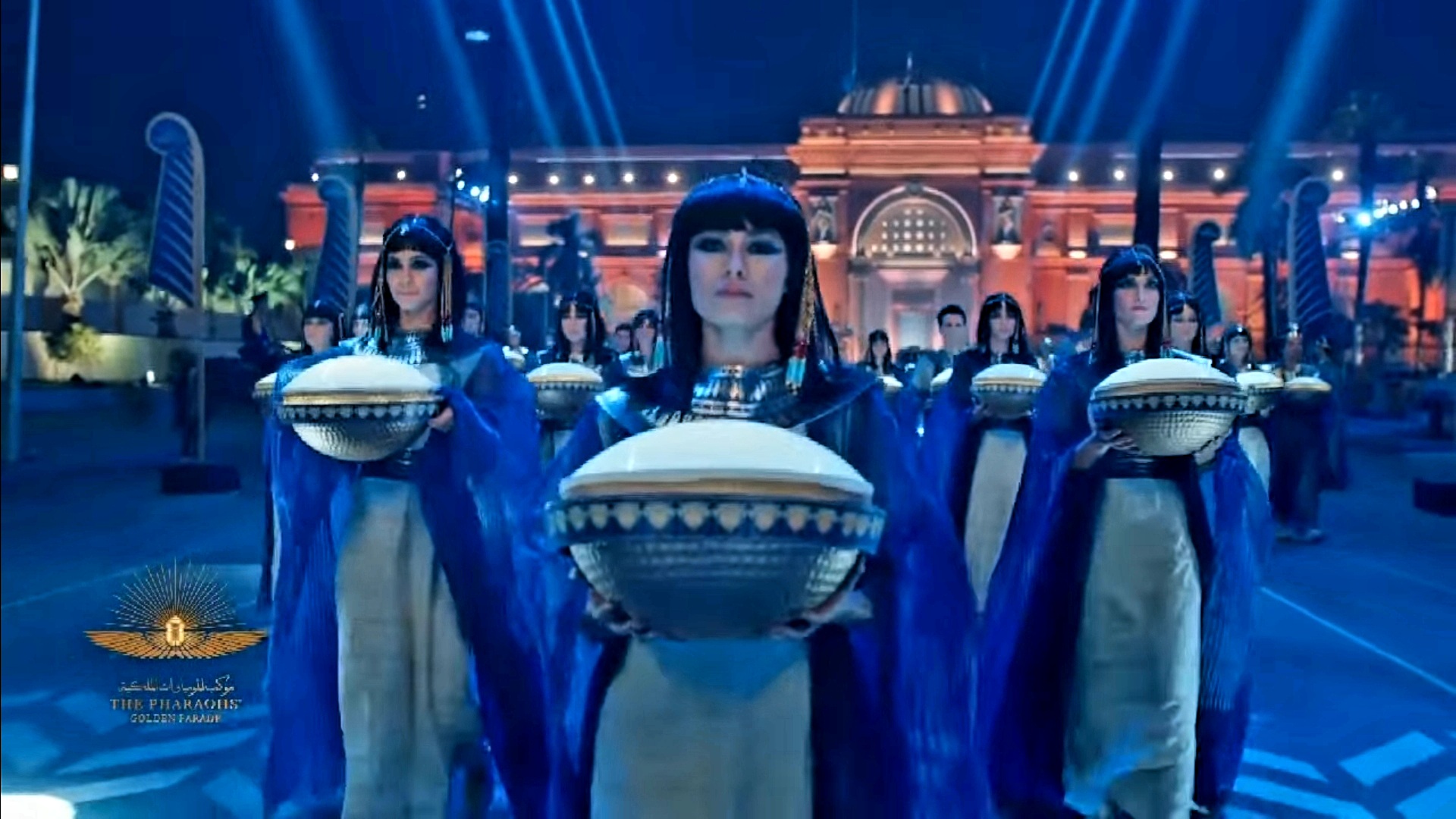
Konvoi der “Goldenen Parade der Pharaonen”
Ein zeremonieller Konvoi, der anlässlich des Umzugs von 22 königlichen Mumien aus dem alten Museum im Zentrum von Kairo in das neue Gebäude des Nationalen Museums für ägyptische Zivilisation durchgeführt und gefeiert wurde, fand unter strengen Sicherheitsmaßnahmen statt, die dem Status der Kulturschatze Ägyptens gerecht wurden.
Während des prunkvollen Spektakels mit Kosten von mehreren Millionen von Dollar wurden die Mumien von 18 Königen und vier Königinnen vom neoklassizistischen Ägyptischen Museum in das fünf Kilometer entfernte neue „National Museum of Egyptian Civilization“ gebracht.
Die Mumien der HerrscherInnen der 17 ägyptischen Dynastien wurden in chronologischer Reihenfolge ihrer Regierungszeit mit großem Pomp überführt, angefangen von Sekenenre Tao II, bis zu Ramses IX der im 12. Jahrhundert v. Chr. Regierte.
Eine der Hauptattraktionen der Goldenen Parade der Pharaonen war der Umzug von König Ramses II. Der berühmteste Pharao des Neuen Königreichs, der 67 Jahre lang regierte und für die Unterzeichnung des ersten bekannten Friedensvertrages in Erinnerung blieb.
Ein Star des Abends war auch die berühmte Königin Hatschepsut, die Herrscherin wurde, entgegen der damaligen Sitte, dass Frauen keine Pharaonen sein könnten.
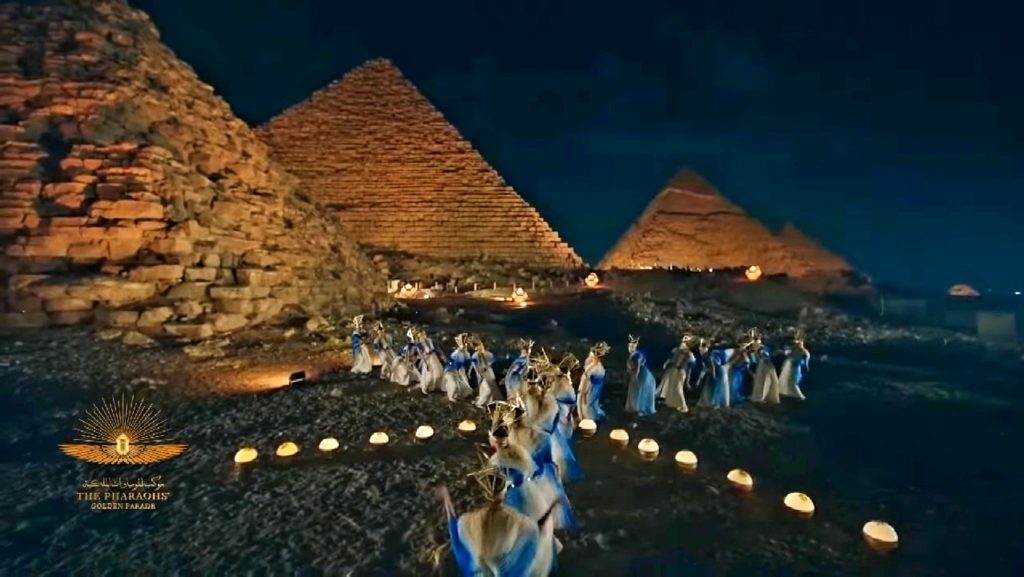
Das höchste Maß an Sicherheit für die Pharaonen
Jede Mumie wurde in einem dekorierten Fahrzeug überführt, das speziell vor Angriffen geschützt und von Eskorten begleitet war.
Die Mumien der Pharaonen und Pharaoninnen wurden extra für die Parade in spezielle mit Stickstoff gefüllte Kisten gelegt, um sie vor äußeren Einflüssen zu schützen, und die Straßen auf dem fünf Kilometer langem Weg wurden erst kürzlich neu asphaltiert, damit ihr Transport reibungslos verlaufen konnte.
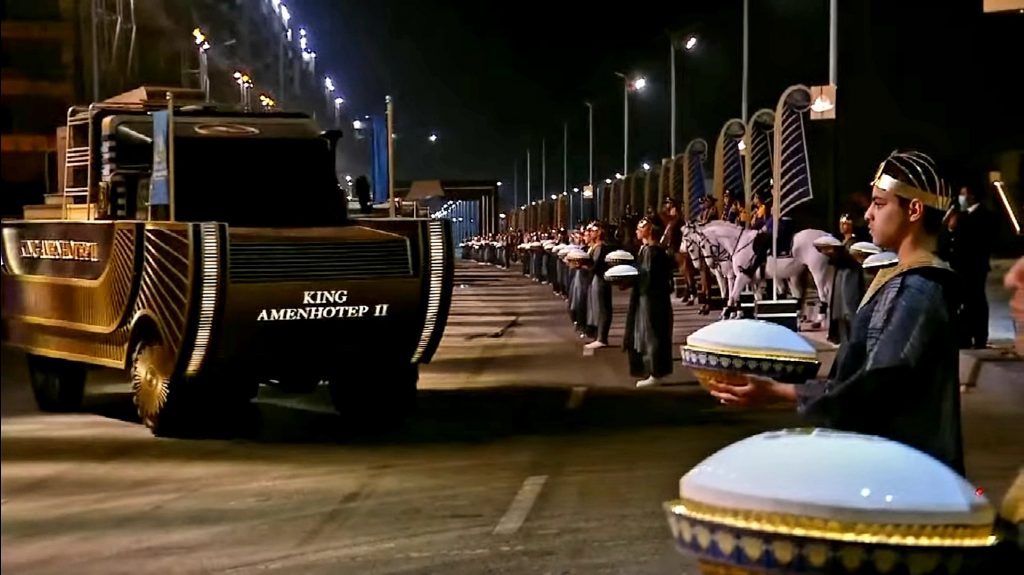
Nationalmuseum der ägyptischen Zivilisation
Die Mumien wurden in den Jahren1881 und 1898 an zwei Orten in den Ruinen von Theben, der damaligen Hauptstadt des alten Ägyptens, dem heutigen Luxor, entdeckt und im Ägyptischen Museum untergebracht, wo sie im letzten Jahrhundert von Millionen von Touristen aus aller Welt besucht wurden.
Das neue Museum wird die Mumien in der Royal Hall beherbergen, die so gestaltet wurde, dass die Besucher die Illusion haben, sich im Tal der Könige in Luxor zu befinden.
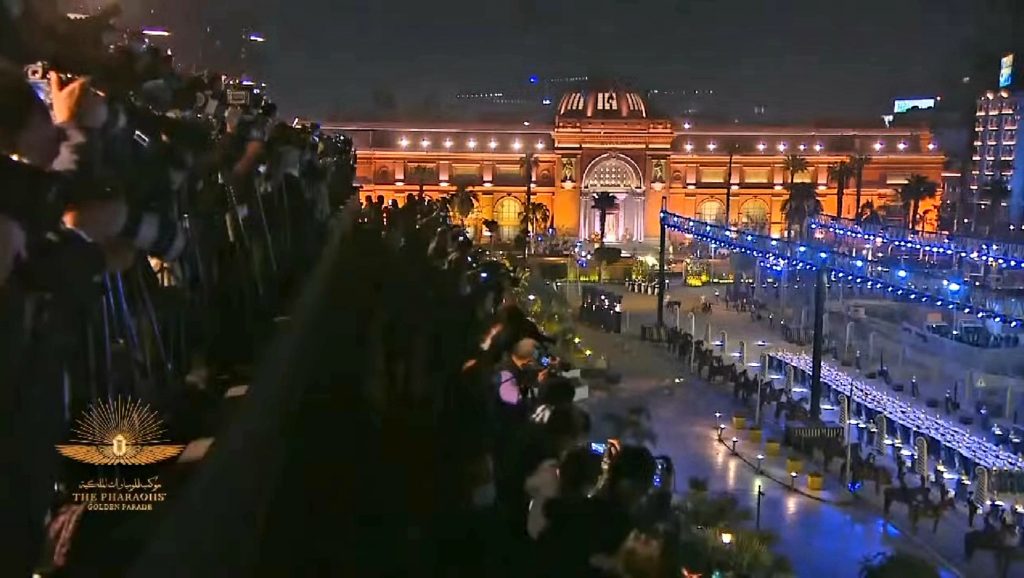
Die Schaffung dieses Museums dauerte fast 20 Jahre
Die Hauptgalerien befinden sich links von der Treppe und sind in vier Epochen unterteilt. Vor-Dynastie, die bis 3100 v. Chr. dauerte, und das Alte Königreich, in dem die Erbauer der Pyramiden lebten. Daneben folgt das Reich des Mittleren, gefolgt vom Neuen Reich – die Zeit von Tutanchamun und Ramses, während am Ende die griechisch-römische Ära gezeigt wird.
Diese chronologischen Epochen sind thematisch unterteilt: Glaube und Ewigkeit (Religion), Königreich und Macht (Herrscher) und Gesellschaft.
Schließlich werden die Besucher zu hohen Glasfenstern mit Blick auf die Pyramiden geleitet und die tragen die Pracht des alten Ägypten mit sich – das große Finale einer chronologischen Show, in der eine der größten Zivilisationen der Welt gefeiert wird.

Tribut an Tutanchamun
In seiner Sammlung besitzt das Museum etwa 100.000 Exponate, und die Hauptattraktion sind die circa 5.600 Gegenstände aus Tutanchamuns Grab.
Rechts von der Treppe befindet sich die Ausstellung von Tutanchamun, in denen zum ersten Mal der Inhalt des gesamten Grabes ausgestellt wird.
Um Tutanchamun Tribut zu zollen, hat das Große Museum von Ägypten zahlreiche ihm gewidmete Galerien sowie eine Nachbildung seines Grabes. Um die Erfahrung noch intensiver zu machen, ist die Nachbildung des Grabes 60-mal größer als das Original. Tutanchamuns äußerer Sarg wird ausgestellt, ebenso wie seine beiden inneren Särge.
Besonders interessant ist der Hinweis zu den “Tut” -Ausstellungen: Die Reliquien werden genauso ausgestellt, wie der Archäologe und Ägyptologe Howard Carter sie im Grab gefunden hat.

Kindermuseum, Kino, Geschäfte, Restaurants…
Innerhalb des Museums gibt es auch ein separates Kindermuseum, das mit Hilfe modernster visueller Tricks Kindern die altägyptische Welt erklärt.
Darüber hinaus wird das größte archäologische Museum der Welt 28 Geschäfte, 10 Restaurants, einen Konferenzsaal und ein Kino in seinem Komplex beherbergen.
Im Museumspark befinden sich Gärten mit Skulpturen. Am Eingang zum Hauptatrium erwartet Sie eine massive Statue von Ramses II. Dann gibt es noch die “Große Treppe”, die zum Plateau führt, wo 87 Statuen von Pharaonen und ägyptischen Göttern ausgestellt werden.
Die Tourismusbranche in Ägypten wurde in den letzten zehn Jahren von den politischen Turbulenzen und in jüngerer Zeit von der Coronavirus-Pandemie negativ beeinflusst. Die ägyptischen Behörden hoffen jedoch, dass das neue Museum, das diesen Monat für Besucher geöffnet wird, dazu beitragen wird, den Tourismus, die wichtigste Devisenquelle des Landes, wiederzubeleben.
English:
The gift of Egypt to the world: National Museum of Egyptian Civilization – the largest archaeological museum in the world
A spectacle under the starry sky of the Sahara
A spectacle the world has never seen before took place at dusk on April 3, 2021 in the Egyptian capital. Stars of the evening – 22 precious mummies. This spectacle was watched live by millions of people around the world.
Everyone who saw this unique event in front of television screens held their breath by the theatricality and the picturesque landscape under the starry sky of the Sahara.
Convoy of the “Golden Parade of the Pharaohs”
A ceremonial convoy, carried out and celebrated on the occasion of the relocation of 22 royal mummies from the old museum in central Cairo to the new building of the National Museum of Egyptian Civilization, took place under tight security measures that lived up to the status of the cultural treasures of Egypt.
During the magnificent spectacle, which cost several million dollars, the mummies of 18 kings and four queens were brought from the neoclassical Egyptian Museum to the new National Museum of Egyptian Civilization, five kilometers away.
The mummies of the rulers of the 17 Egyptian dynasties were transferred with great pomp in the chronological order of their reigns, from Sekenenre Tao II to Ramses IX of the 12th century BC. BC ruled.
One of the main attractions of the Pharaohs Golden Parade was the procession of King Ramses II. The New Kingdom’s most famous pharaoh, who ruled for 67 years and is remembered for signing the first known peace treaty.
Another star of the evening was the famous Queen Hatshepsut, who became ruler, contrary to the custom of the time that women could not be pharaohs.

The highest level of security for the pharaohs
Each mummy was transferred in a decorated vehicle that was specially protected from attacks and accompanied by escorts.
The mummies of the pharaohs were placed in special nitrogen-filled boxes especially for the parade to protect them from external influences, and the roads on the five-kilometer path were recently repaved so that their transport could run smoothly.
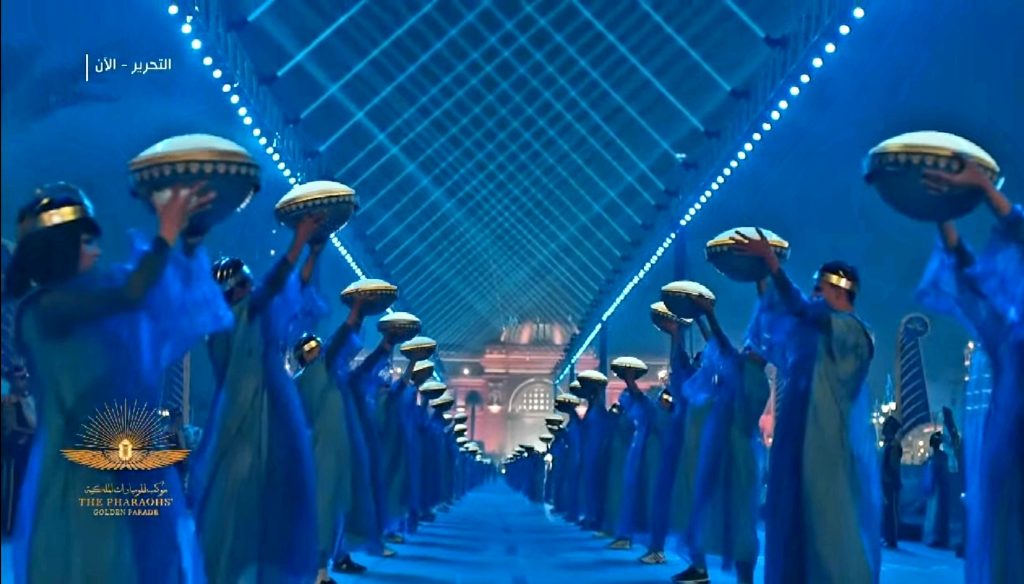
National Museum of Egyptian Civilization
The mummies were discovered in 1881 and 1898 in two places in the ruins of Thebes, the then capital of ancient Egypt, now Luxor, and housed in the Egyptian Museum, where they were visited by millions of tourists from all over the world over the last century.
The new museum will house the mummies in the Royal Hall, which has been designed to give visitors the illusion of being in the Valley of the Kings in Luxor.

The creation of this museum took almost 20 years
The main galleries are to the left of the stairs and are divided into four eras. Pre-dynasty, which lasted until 3100 BC. And the Old Kingdom where the builders of the pyramids lived. This is followed by the Middle Kingdom, followed by the New Kingdom – the time of Tutankhamun and Ramses, while at the end the Greco-Roman era is shown.
These chronological epochs are divided thematically: Faith and Eternity (religion), Kingdom and power (rulers), and Society.
Finally, visitors are directed to tall glass windows overlooking the pyramids, which carry the grandeur of ancient Egypt with them – the grand finale of a chronological show celebrating one of the world’s greatest civilizations.

Tribute to Tutankhamun
The museum has around 100,000 exhibits in its collection, and the main attraction is the approximately 5,600 items from Tutankhamun’s tomb.
To the right of the stairs is Tutankhamun’s exhibition, which for the first time exhibits the contents of the entire tomb.
To pay tribute to Tutankhamun, the Great Museum of Egypt has numerous galleries dedicated to him, as well as a replica of his tomb. To make the experience even more intense, the replica of the tomb is 60 times larger than the original. Tutankhamun’s outer coffin is on display, as are his two inner coffins.
The reference to the “Tut” exhibitions is particularly interesting: the relics are exhibited exactly as the archaeologist and Egyptologist Howard Carter found them in the grave.


Children’s museum, cinema, shops, restaurants …
There is also a separate children’s museum within the museum, which uses the most modern visual tricks to explain the ancient Egyptian world to children.
In addition, the largest archaeological museum in the world will house 28 shops, 10 restaurants, a conference hall and a cinema in its complex.
There are gardens with sculptures in the museum park. A massive statue of Ramses II awaits you at the entrance to the main atrium. Then there is the “Great Staircase” that leads to the plateau, where 87 statues of pharaohs and Egyptian gods are exhibited.
The tourism industry in Egypt has been negatively impacted by the political turmoil for the past decade and, more recently, by the coronavirus pandemic. However, the Egyptian authorities hope that the new museum, which opens to visitors this month, will help revitalize tourism, the country’s main source of foreign currency.
Text: Svetlana Nenadovic Glusac